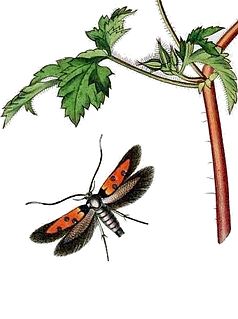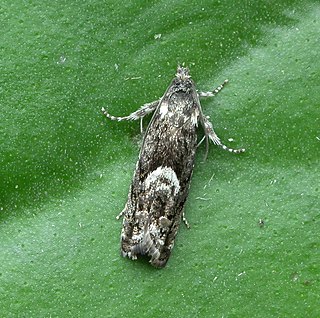Related Research Articles

Pears are fruits produced and consumed around the world, growing on a tree and harvested in late Summer into October. The pear tree and shrub are a species of genus Pyrus, in the family Rosaceae, bearing the pomaceous fruit of the same name. Several species of pears are valued for their edible fruit and juices, while others are cultivated as trees.

Galls or cecidia are a kind of swelling growth on the external tissues of plants, fungi, or animals. Plant galls are abnormal outgrowths of plant tissues, similar to benign tumors or warts in animals. They can be caused by various parasites, from viruses, fungi and bacteria, to other plants, insects and mites. Plant galls are often highly organized structures so that the cause of the gall can often be determined without the actual agent being identified. This applies particularly to some insect and mite plant galls. The study of plant galls is known as cecidology.

The Agonoxeninae are a subfamily of moths.

Cactoblastis cactorum, the cactus moth, South American cactus moth or nopal moth, is native to Argentina, Paraguay, Uruguay and southern Brazil. It is one of five species in the genus Cactoblastis that inhabit South America, where many parasitoids and pathogens control the expansion of the moths' population. This species has been introduced into many areas outside its natural range, including Australia, the Caribbean, and South Africa. In some locations, it has spread uncontrollably and was consequently classified an invasive species. However, in other places such as Australia, it has gained favor for its role in the biological control of cacti from the genus Opuntia, such as prickly pear.

Gymnosporangium sabinae is a fungal heteroecious plant pathogen with Juniperus as the primary (telial) host and only Pyrus as secondary (aecial) hosts. It is one of many types of rust fungi affecting plants.

Blastodacna atra, the apple pith moth is a moth of the family Elachistidae. It is known from most of Europe and it has been introduced to North America.

The Phycitinae are a subfamily of snout moths. Even though the Pyralidae subfamilies are all quite diverse, Phycitinae stand out even by standards of their family: with over 600 genera considered valid and more than 4000 species placed here at present, they unite up more than three-quarters of living snout moth diversity. Together with the closely related Epipaschiinae, they are apparently the most advanced lineage of snout moths.

Synanthedon formicaeformis, the red-tipped clearwing, is a moth of the family Sesiidae and can be found in all of Europe, the eastern Palearctic realm, and the Near East. The larvae sometimes form pear-shaped galls on willows. It was first described by Eugenius Johann Christoph Esper in 1783.

Blastodacna is a genus of moths of the family Elachistidae.

Blastodacna hellerella is a moth in the family Elachistidae. It is found in most of Europe except the north. In the east, the range extends to the Caucasus.
Blastodacna libanotica is a moth in the family Elachistidae. It is found in Anatolia and the Near East.
Haplochrois theae is a species of moth of the family Elachistidae. It is found from western Transcaucasia and Anatolia to China. It probably originated from Southeast Asia. During the 20th century, this species was a serious pest on tea plantations in Georgia and to a lesser degree, in the Krasnodar Territory of Russia.
Synanthedon flaviventris, the sallow clearwing, is a moth of the family Sesiidae. The larvae form pear-shaped galls on sallows.
Lobesia virulenta is a moth of the family Tortricidae. It was described by Bae & Komai in 1991. It is found from northern Europe to Japan.

Parametriotinae is a subfamily of moths in the family Elachistidae.
Blastodacna erebopis is a moth in the family Elachistidae. It is found on Java.
Blastodacna mandshurica is a moth in the family Elachistidae. It is found in Russia.

Pammene giganteana is a micromoth belonging to the family Tortricidae. The species was first described by Henri de Peyerimhoff in 1863.

Pammene albuginana is a moth belonging to the family Tortricidae. The species was first described by Achille Guenée in 1845.
UFC Fight Night 192 is an upcoming mixed martial arts event produced by the Ultimate Fighting Championship that will take place on July 24, 2021 at a TBA location.
References
- ↑ Beccaloni, G.; Scoble, M.; Kitching, I.; Simonsen, T.; Robinson, G.; Pitkin, B.; Hine, A.; Lyal, C., eds. (2003). "Blastodacna pyrigalla". The Global Lepidoptera Names Index . Natural History Museum . Retrieved May 19, 2018.
- ↑ "Blastodacna". www.nic.funet.fi. Retrieved 2021-05-19.
- ↑ "Europe PMC". europepmc.org. Retrieved 2021-05-19.